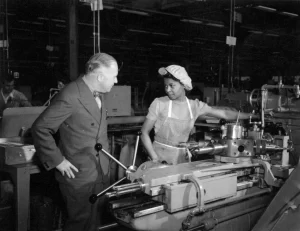Uncle Sam Wants You, Too–Pt 2

Sayde R. Carter working a lathe at the Sperry Gyroscope plant on Long Island, New York. Hagley Museum and Library.
After my last blog post, about how women were recruited for war work during World War II, a dear friend and regular reader asked me whether similar ads were run in publications read by minorities. It’s a good question, and one I’m slightly ashamed that I didn’t ask. Certainly the women in the recruiting posters that I found all had white faces.*
I don’t have a solid answer, but here’s what I found in a first pass:**
- I found nothing about ads in magazines aimed at Black women, though such magazines existed. I found references to ads for women in the Army in black newspapers. Applications were available in all post offices, but Black women were often turned away when they tried to apply. Even when Black women were given applications, the number accepted was small. The Women’s Army Auxiliary Corps (WAAC) , later the Women’s Army Corps (WAC), had a policy limiting the number of Black women to ten percent of the whole. Those who were allowed to enlist were often given menial jobs regardless of their qualifications. Initially no Black units were assigned overseas. The one exception to this was 6888th Central Postal Directory Battalion, which was sent first to England and then to France to deal with a huge backlog of mail.
- The other U.S. military services did not accept any Black women initially, and never accepted many.
- Black women (and men) were initially turned away from factory jobs by managers who preferred to hire white men, and failing that white women. In the summer 1941, President Roosevelt became aware of the widespread hiring discrimination thanks to activists Mary McLeod Bethune and A. Phillip Randolph. He signed an executive order banning racial discrimination. Ultimately, more than half a million “Black Rosies” worked in shipyards and factories, though my guess is that they continued to face discrimination on the job.
- If the National Archives excellent blog, The Unwritten Record,*** is to be believed, I didn’t find images of Black women in war work recruiting posters because they weren’t included in war materials produced by the Office of War Information—erasing them from the story even as it happened. ****
None of which answers the original question, which would require some nitty gritty academic work in original sources.
If any of you have something to add to the story, I would love to hear it.
* Asking “Who’s not in the picture?” is as important as “Who’s telling the story?” The learning curve continues. Please, please, ask me the hard questions when I fail to ask them myself.
**I limited my search specifically to Black women, rather than looking for minorities as a whole.
***The Unwritten Record is produced by the Special Media Records Division of the National Archive. I learn something new with every post.
****Again, for those sitting in the back: “Who’s telling the story?” is a good question to ask.




